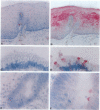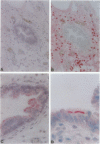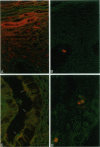Abstract
This study describes the novel localization of the antimicrobial peptide human intestinal defensin-5 (HD-5) in female genital tract epithelia. Using a 3' rapid amplification of cDNA ends (RACE) protocol, HD-5 was cloned from a vaginal epithelial cell RNA preparation, and its identity was confirmed by sequencing. Tissue samples from multiple donors were subsequently screened for HD-5 expression by reverse transcription polymerase chain reaction. HD-5 message was invariantly expressed by normal vagina and ectocervix and inflamed fallopian tube, but variably expressed by normal endocervix, endometrium, and fallopian tube (60, 64, and 29% of specimens, respectively). Expression in endometrium was the highest during the early secretory phase of the menstrual cycle. Using immunohistochemistry and confocal microscopy, HD-5 peptide was localized in the upper half of the stratified squamous epithelium of the vagina and ectocervix, with the intensity of cellular staining increasing toward the lumen. In positive endocervix, endometrium, and fallopian tube specimens, HD-5 was located in apically oriented granules and on the apical surface of a proportion of columnar epithelial cells. Using Western blot analysis, secreted HD-5 was detected in cervicovaginal lavages, with the highest concentrations found during the secretory phase of the menstrual cycle. We hypothesize that HD-5 is an intrinsic component of the female urogenital innate immune defense system and that its expression may be modulated by hormonal and proinflammatory factors.
Full text
PDF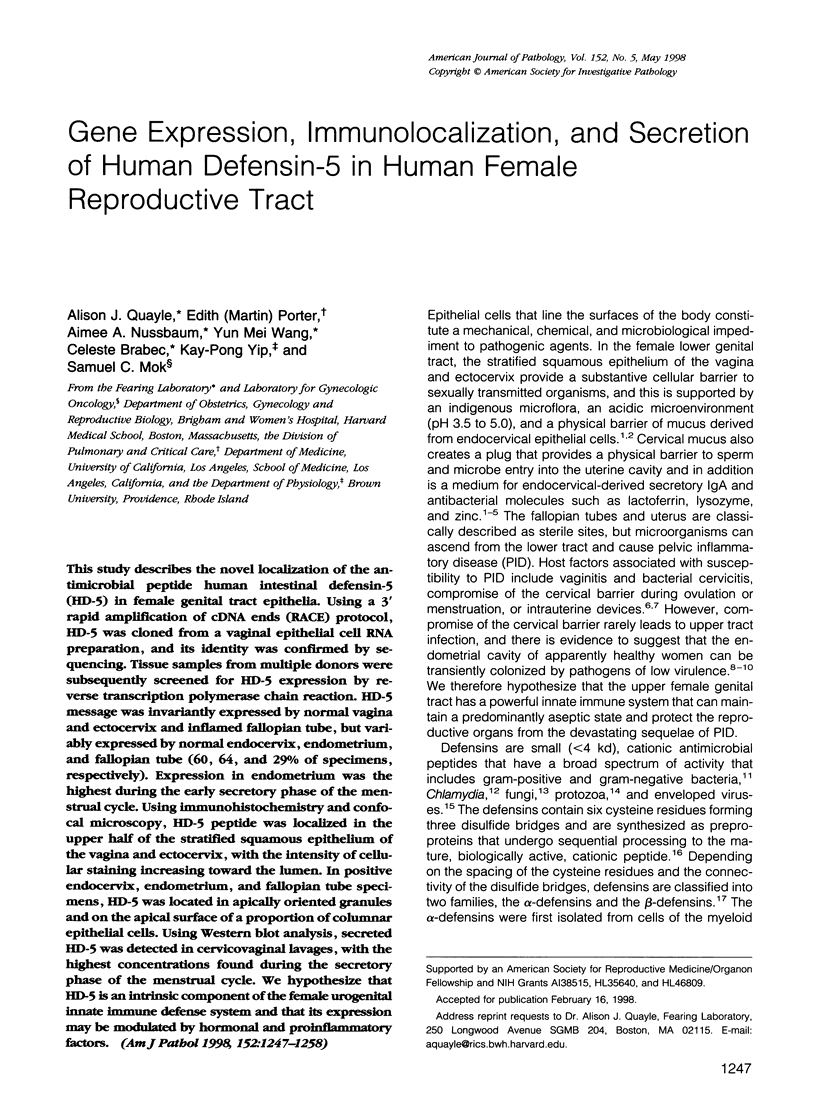
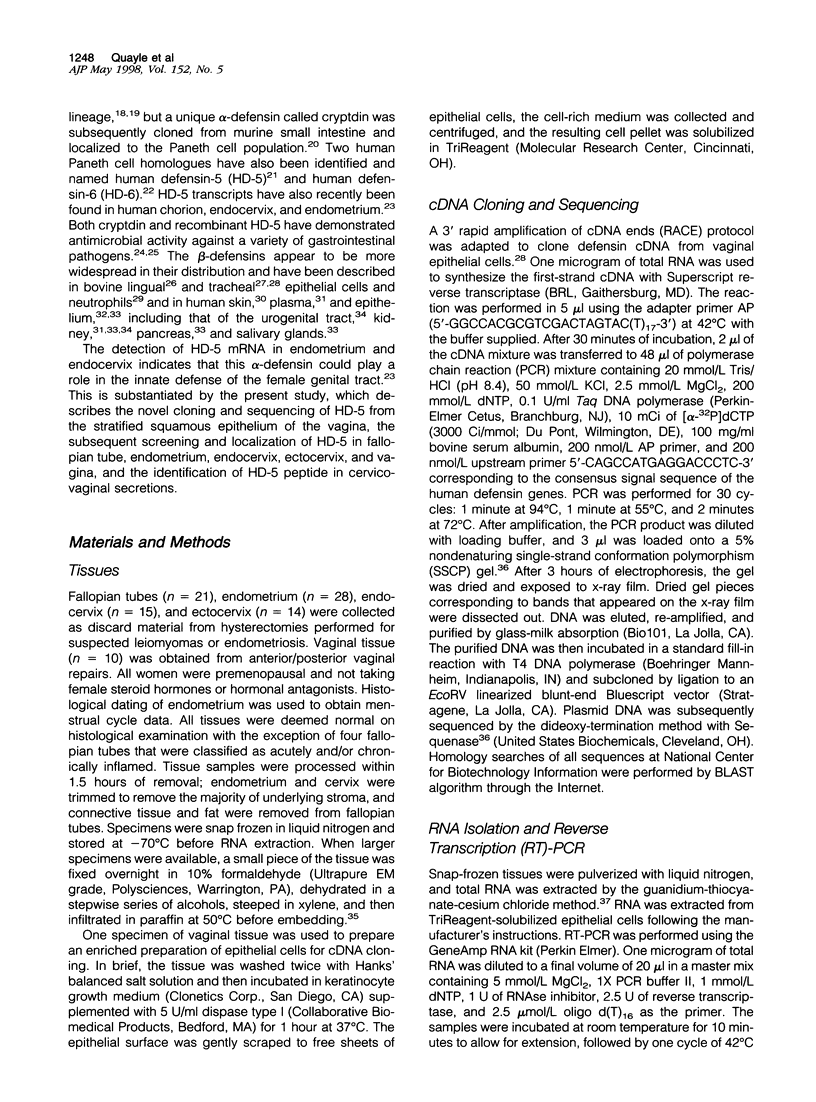

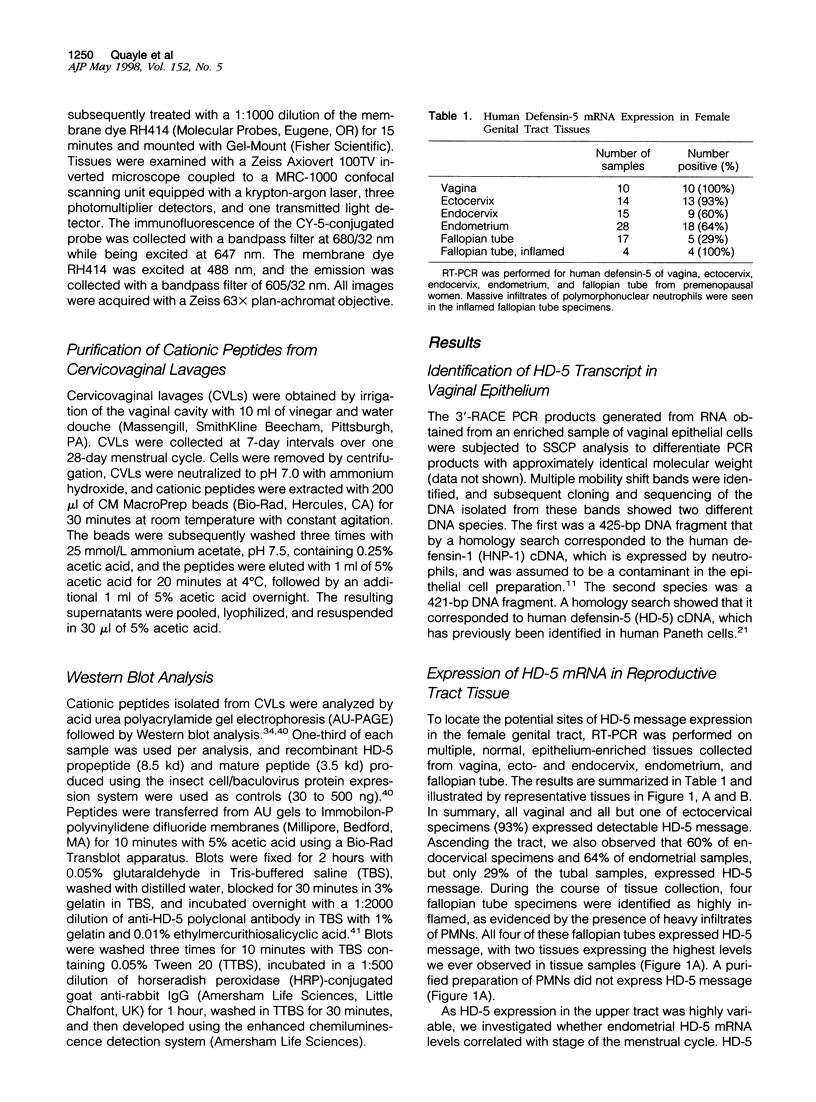

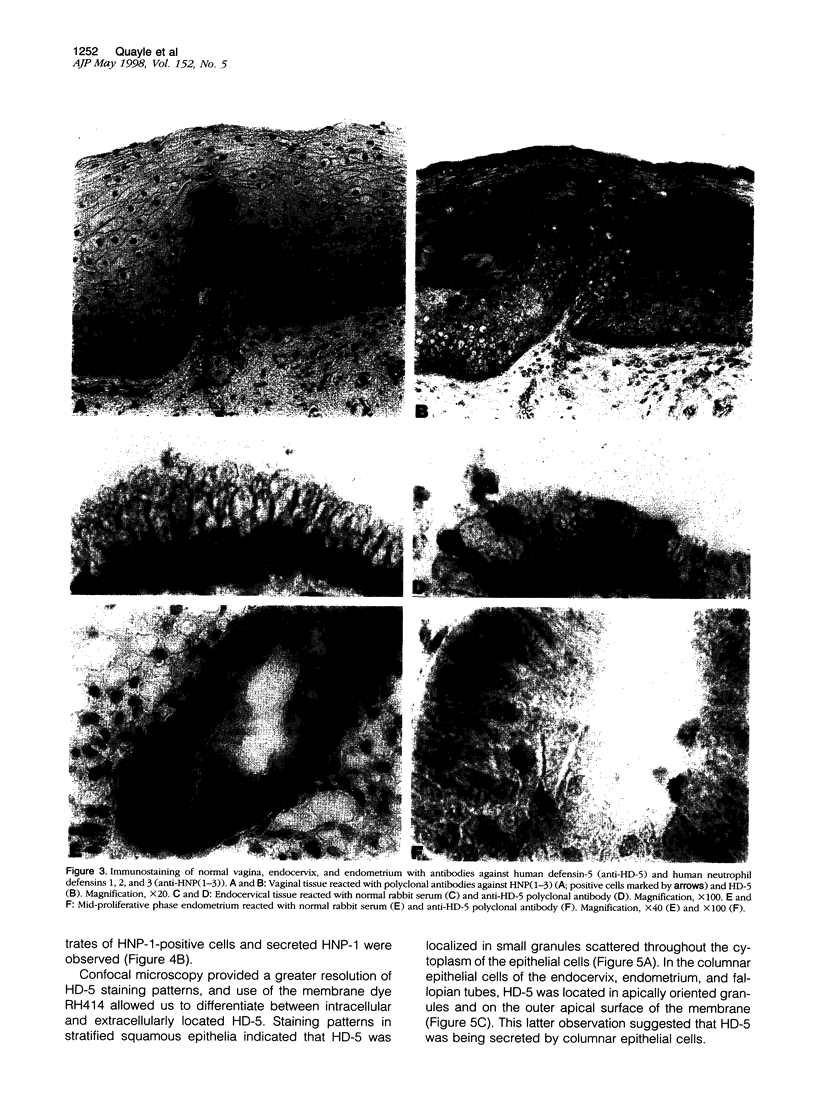
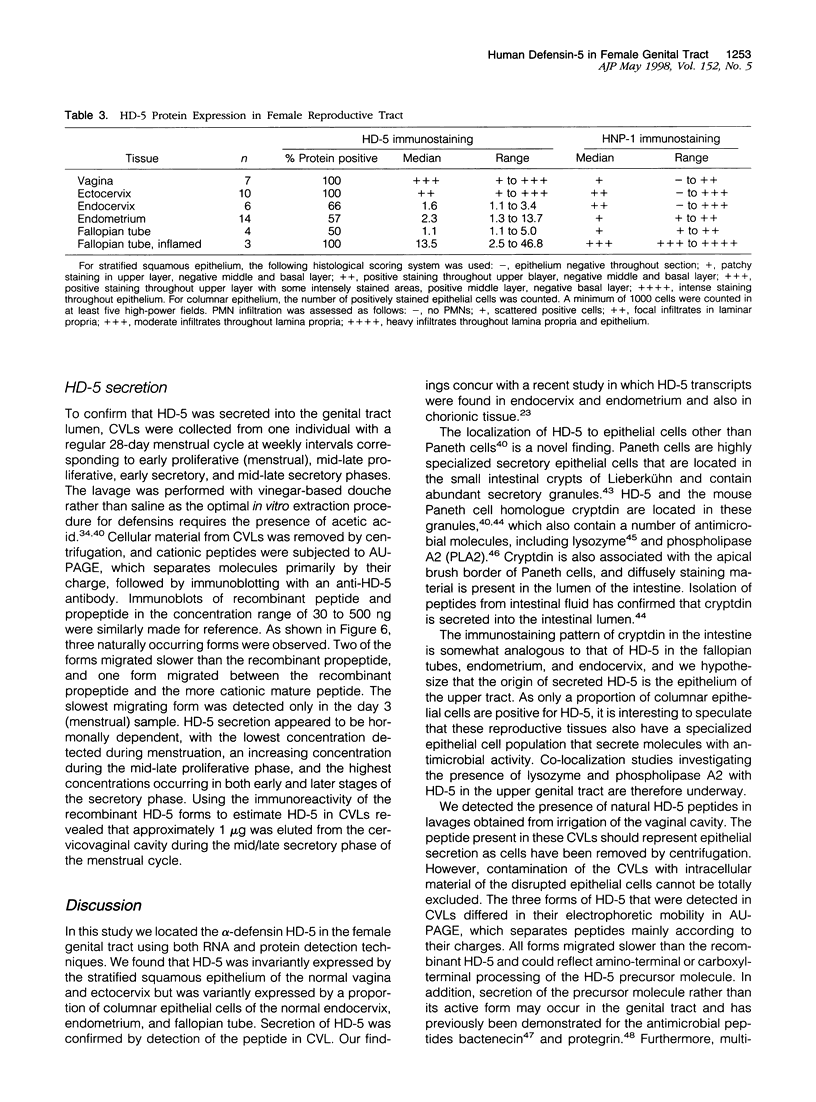
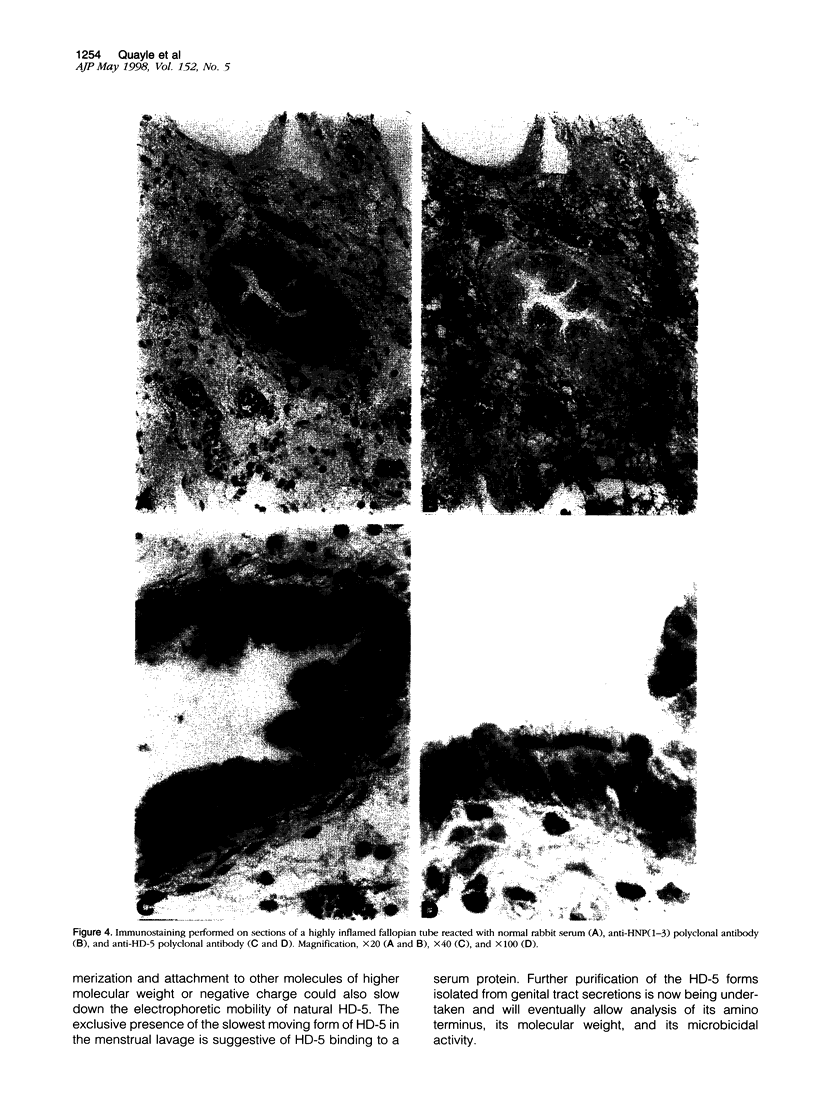
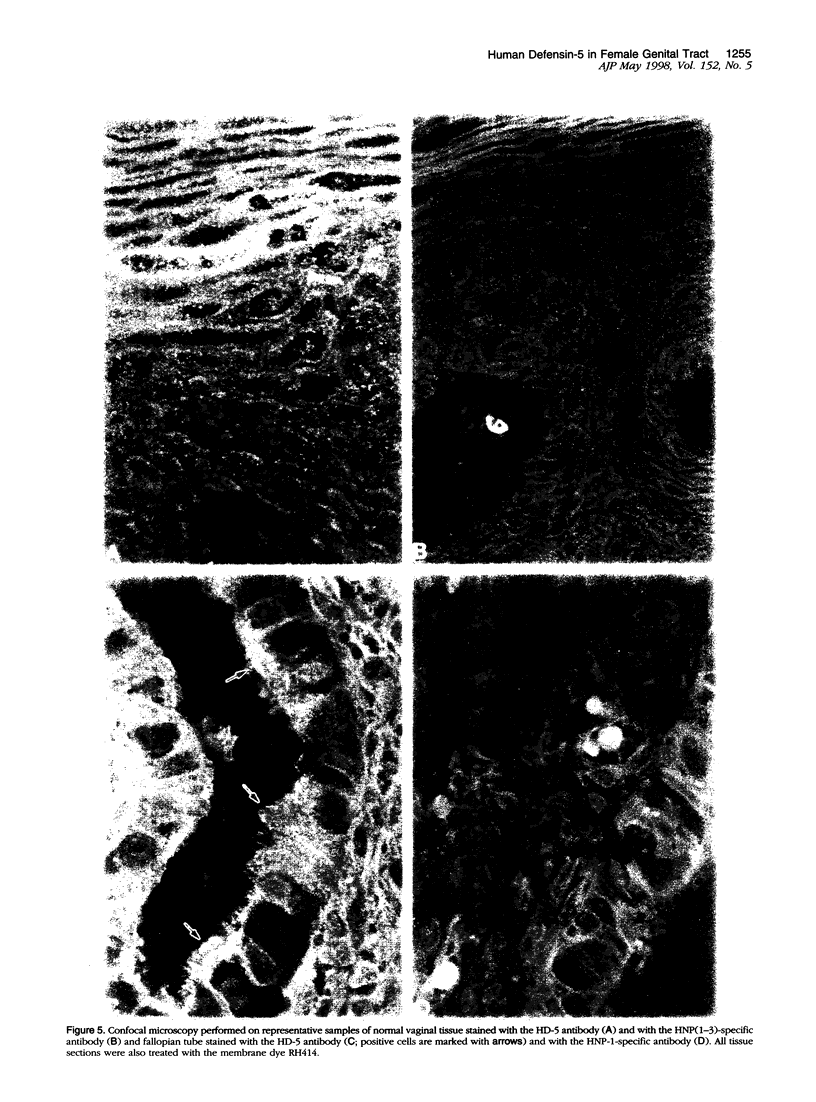

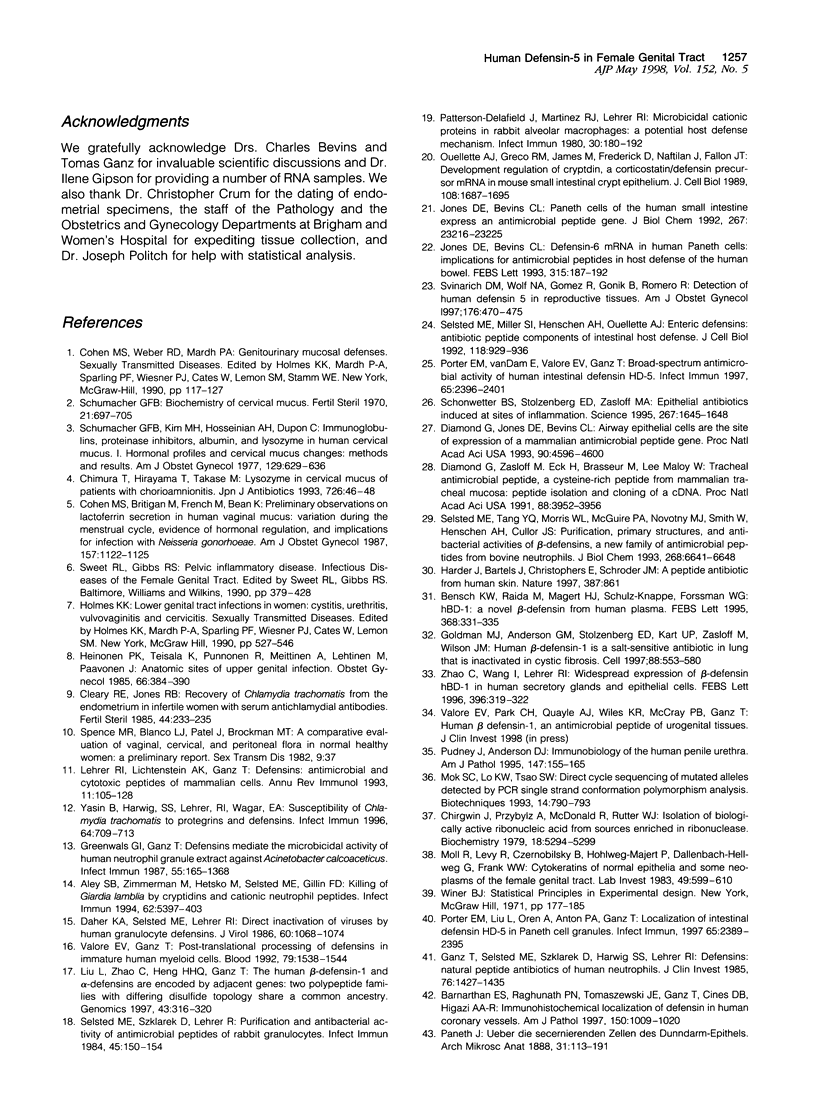
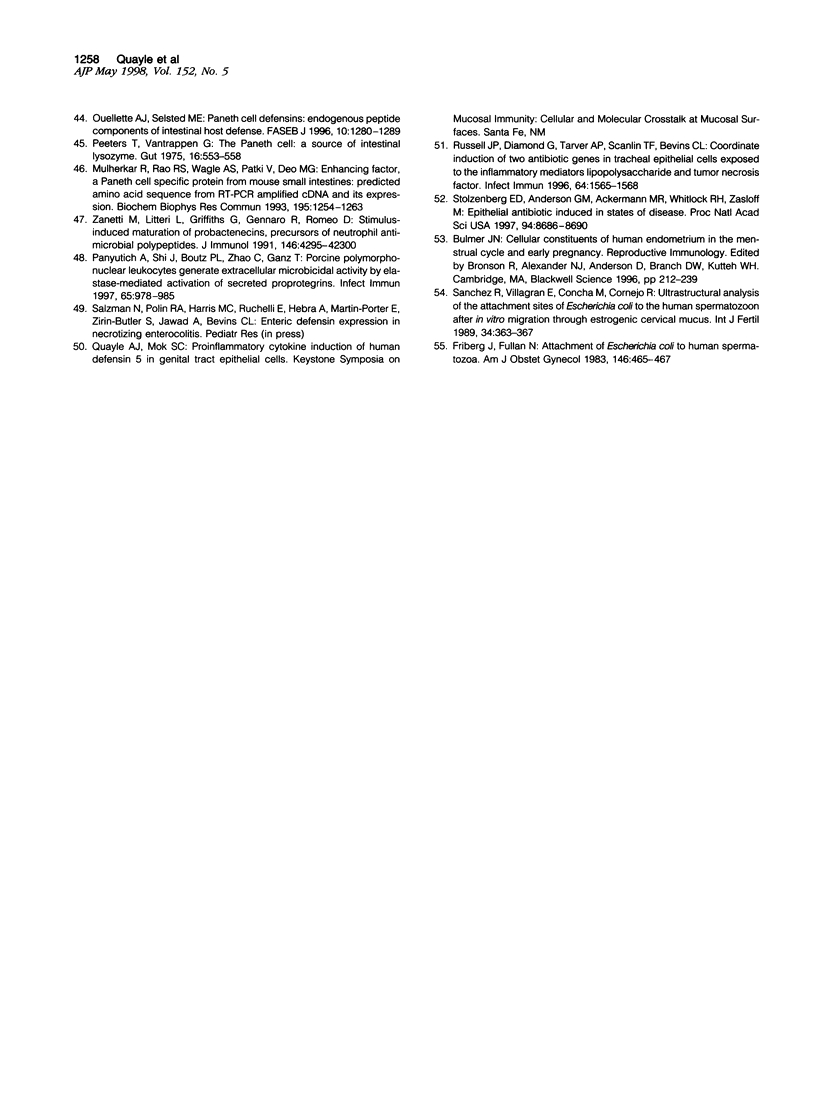
Images in this article
Selected References
These references are in PubMed. This may not be the complete list of references from this article.
- Aley S. B., Zimmerman M., Hetsko M., Selsted M. E., Gillin F. D. Killing of Giardia lamblia by cryptdins and cationic neutrophil peptides. Infect Immun. 1994 Dec;62(12):5397–5403. doi: 10.1128/iai.62.12.5397-5403.1994. [DOI] [PMC free article] [PubMed] [Google Scholar]
- Barnathan E. S., Raghunath P. N., Tomaszewski J. E., Ganz T., Cines D. B., Higazi A al-R Immunohistochemical localization of defensin in human coronary vessels. Am J Pathol. 1997 Mar;150(3):1009–1020. [PMC free article] [PubMed] [Google Scholar]
- Bensch K. W., Raida M., Mägert H. J., Schulz-Knappe P., Forssmann W. G. hBD-1: a novel beta-defensin from human plasma. FEBS Lett. 1995 Jul 17;368(2):331–335. doi: 10.1016/0014-5793(95)00687-5. [DOI] [PubMed] [Google Scholar]
- Chirgwin J. M., Przybyla A. E., MacDonald R. J., Rutter W. J. Isolation of biologically active ribonucleic acid from sources enriched in ribonuclease. Biochemistry. 1979 Nov 27;18(24):5294–5299. doi: 10.1021/bi00591a005. [DOI] [PubMed] [Google Scholar]
- Cleary R. E., Jones R. B. Recovery of Chlamydia trachomatis from the endometrium in infertile women with serum antichlamydial antibodies. Fertil Steril. 1985 Aug;44(2):233–235. doi: 10.1016/s0015-0282(16)48743-1. [DOI] [PubMed] [Google Scholar]
- Cohen M. S., Britigan B. E., French M., Bean K. Preliminary observations on lactoferrin secretion in human vaginal mucus: variation during the menstrual cycle, evidence of hormonal regulation, and implications for infection with Neisseria gonorrhoeae. Am J Obstet Gynecol. 1987 Nov;157(5):1122–1125. doi: 10.1016/s0002-9378(87)80274-0. [DOI] [PubMed] [Google Scholar]
- Daher K. A., Selsted M. E., Lehrer R. I. Direct inactivation of viruses by human granulocyte defensins. J Virol. 1986 Dec;60(3):1068–1074. doi: 10.1128/jvi.60.3.1068-1074.1986. [DOI] [PMC free article] [PubMed] [Google Scholar]
- Diamond G., Jones D. E., Bevins C. L. Airway epithelial cells are the site of expression of a mammalian antimicrobial peptide gene. Proc Natl Acad Sci U S A. 1993 May 15;90(10):4596–4600. doi: 10.1073/pnas.90.10.4596. [DOI] [PMC free article] [PubMed] [Google Scholar]
- Diamond G., Zasloff M., Eck H., Brasseur M., Maloy W. L., Bevins C. L. Tracheal antimicrobial peptide, a cysteine-rich peptide from mammalian tracheal mucosa: peptide isolation and cloning of a cDNA. Proc Natl Acad Sci U S A. 1991 May 1;88(9):3952–3956. doi: 10.1073/pnas.88.9.3952. [DOI] [PMC free article] [PubMed] [Google Scholar]
- Friberg J., Fullan N. Attachment of Escherichia coli to human spermatozoa. Am J Obstet Gynecol. 1983 Jun 15;146(4):465–467. doi: 10.1016/0002-9378(83)90831-1. [DOI] [PubMed] [Google Scholar]
- Ganz T., Selsted M. E., Szklarek D., Harwig S. S., Daher K., Bainton D. F., Lehrer R. I. Defensins. Natural peptide antibiotics of human neutrophils. J Clin Invest. 1985 Oct;76(4):1427–1435. doi: 10.1172/JCI112120. [DOI] [PMC free article] [PubMed] [Google Scholar]
- Goldman M. J., Anderson G. M., Stolzenberg E. D., Kari U. P., Zasloff M., Wilson J. M. Human beta-defensin-1 is a salt-sensitive antibiotic in lung that is inactivated in cystic fibrosis. Cell. 1997 Feb 21;88(4):553–560. doi: 10.1016/s0092-8674(00)81895-4. [DOI] [PubMed] [Google Scholar]
- Greenwald G. I., Ganz T. Defensins mediate the microbicidal activity of human neutrophil granule extract against Acinetobacter calcoaceticus. Infect Immun. 1987 Jun;55(6):1365–1368. doi: 10.1128/iai.55.6.1365-1368.1987. [DOI] [PMC free article] [PubMed] [Google Scholar]
- Harder J., Bartels J., Christophers E., Schröder J. M. A peptide antibiotic from human skin. Nature. 1997 Jun 26;387(6636):861–861. doi: 10.1038/43088. [DOI] [PubMed] [Google Scholar]
- Heinonen P. K., Teisala K., Punnonen R., Miettinen A., Lehtinen M., Paavonen J. Anatomic sites of upper genital tract infection. Obstet Gynecol. 1985 Sep;66(3):384–390. [PubMed] [Google Scholar]
- Jones D. E., Bevins C. L. Defensin-6 mRNA in human Paneth cells: implications for antimicrobial peptides in host defense of the human bowel. FEBS Lett. 1993 Jan 4;315(2):187–192. doi: 10.1016/0014-5793(93)81160-2. [DOI] [PubMed] [Google Scholar]
- Jones D. E., Bevins C. L. Paneth cells of the human small intestine express an antimicrobial peptide gene. J Biol Chem. 1992 Nov 15;267(32):23216–23225. [PubMed] [Google Scholar]
- Lehrer R. I., Lichtenstein A. K., Ganz T. Defensins: antimicrobial and cytotoxic peptides of mammalian cells. Annu Rev Immunol. 1993;11:105–128. doi: 10.1146/annurev.iy.11.040193.000541. [DOI] [PubMed] [Google Scholar]
- Liu L., Zhao C., Heng H. H., Ganz T. The human beta-defensin-1 and alpha-defensins are encoded by adjacent genes: two peptide families with differing disulfide topology share a common ancestry. Genomics. 1997 Aug 1;43(3):316–320. doi: 10.1006/geno.1997.4801. [DOI] [PubMed] [Google Scholar]
- Mok S. C., Lo K. W., Tsao S. W. Direct cycle sequencing of mutated alleles detected by PCR single-strand conformation polymorphism analysis. Biotechniques. 1993 May;14(5):790–794. [PubMed] [Google Scholar]
- Moll R., Levy R., Czernobilsky B., Hohlweg-Majert P., Dallenbach-Hellweg G., Franke W. W. Cytokeratins of normal epithelia and some neoplasms of the female genital tract. Lab Invest. 1983 Nov;49(5):599–610. [PubMed] [Google Scholar]
- Mulherkar R., Rao R. S., Wagle A. S., Patki V., Deo M. G. Enhancing factor, a Paneth cell specific protein from mouse small intestines: predicted amino acid sequence from RT-PCR amplified cDNA and its expression. Biochem Biophys Res Commun. 1993 Sep 30;195(3):1254–1263. doi: 10.1006/bbrc.1993.2179. [DOI] [PubMed] [Google Scholar]
- Ouellette A. J., Greco R. M., James M., Frederick D., Naftilan J., Fallon J. T. Developmental regulation of cryptdin, a corticostatin/defensin precursor mRNA in mouse small intestinal crypt epithelium. J Cell Biol. 1989 May;108(5):1687–1695. doi: 10.1083/jcb.108.5.1687. [DOI] [PMC free article] [PubMed] [Google Scholar]
- Ouellette A. J., Selsted M. E. Paneth cell defensins: endogenous peptide components of intestinal host defense. FASEB J. 1996 Sep;10(11):1280–1289. doi: 10.1096/fasebj.10.11.8836041. [DOI] [PubMed] [Google Scholar]
- Panyutich A., Shi J., Boutz P. L., Zhao C., Ganz T. Porcine polymorphonuclear leukocytes generate extracellular microbicidal activity by elastase-mediated activation of secreted proprotegrins. Infect Immun. 1997 Mar;65(3):978–985. doi: 10.1128/iai.65.3.978-985.1997. [DOI] [PMC free article] [PubMed] [Google Scholar]
- Patterson-Delafield J., Martinez R. J., Lehrer R. I. Microbicidal cationic proteins in rabbit alveolar macrophages: a potential host defense mechanism. Infect Immun. 1980 Oct;30(1):180–192. doi: 10.1128/iai.30.1.180-192.1980. [DOI] [PMC free article] [PubMed] [Google Scholar]
- Peeters T., Vantrappen G. The Paneth cell: a source of intestinal lysozyme. Gut. 1975 Jul;16(7):553–558. doi: 10.1136/gut.16.7.553. [DOI] [PMC free article] [PubMed] [Google Scholar]
- Porter E. M., Liu L., Oren A., Anton P. A., Ganz T. Localization of human intestinal defensin 5 in Paneth cell granules. Infect Immun. 1997 Jun;65(6):2389–2395. doi: 10.1128/iai.65.6.2389-2395.1997. [DOI] [PMC free article] [PubMed] [Google Scholar]
- Porter E. M., van Dam E., Valore E. V., Ganz T. Broad-spectrum antimicrobial activity of human intestinal defensin 5. Infect Immun. 1997 Jun;65(6):2396–2401. doi: 10.1128/iai.65.6.2396-2401.1997. [DOI] [PMC free article] [PubMed] [Google Scholar]
- Pudney J., Anderson D. J. Immunobiology of the human penile urethra. Am J Pathol. 1995 Jul;147(1):155–165. [PMC free article] [PubMed] [Google Scholar]
- Russell J. P., Diamond G., Tarver A. P., Scanlin T. F., Bevins C. L. Coordinate induction of two antibiotic genes in tracheal epithelial cells exposed to the inflammatory mediators lipopolysaccharide and tumor necrosis factor alpha. Infect Immun. 1996 May;64(5):1565–1568. doi: 10.1128/iai.64.5.1565-1568.1996. [DOI] [PMC free article] [PubMed] [Google Scholar]
- Schonwetter B. S., Stolzenberg E. D., Zasloff M. A. Epithelial antibiotics induced at sites of inflammation. Science. 1995 Mar 17;267(5204):1645–1648. doi: 10.1126/science.7886453. [DOI] [PubMed] [Google Scholar]
- Schumacher G. F. Biochemistry of cervical mucus. Fertil Steril. 1970 Oct;21(10):697–705. [PubMed] [Google Scholar]
- Schumacher G. F., Kim M. H., Hosseinian A. H., Dupon C. Immunoglobulins, proteinase inhibitors, albumin, and lysozyme in human cervical mucus. I. Communication: hormonal profiles and cervical mucus changes--methods and results. Am J Obstet Gynecol. 1977 Nov 15;129(6):629–636. doi: 10.1016/0002-9378(77)90644-5. [DOI] [PubMed] [Google Scholar]
- Selsted M. E., Miller S. I., Henschen A. H., Ouellette A. J. Enteric defensins: antibiotic peptide components of intestinal host defense. J Cell Biol. 1992 Aug;118(4):929–936. doi: 10.1083/jcb.118.4.929. [DOI] [PMC free article] [PubMed] [Google Scholar]
- Selsted M. E., Szklarek D., Lehrer R. I. Purification and antibacterial activity of antimicrobial peptides of rabbit granulocytes. Infect Immun. 1984 Jul;45(1):150–154. doi: 10.1128/iai.45.1.150-154.1984. [DOI] [PMC free article] [PubMed] [Google Scholar]
- Selsted M. E., Tang Y. Q., Morris W. L., McGuire P. A., Novotny M. J., Smith W., Henschen A. H., Cullor J. S. Purification, primary structures, and antibacterial activities of beta-defensins, a new family of antimicrobial peptides from bovine neutrophils. J Biol Chem. 1993 Mar 25;268(9):6641–6648. [PubMed] [Google Scholar]
- Spence M. R., Blanco L. J., Patel J., Brockman M. T. A comparative evaluation of vaginal, cervical and peritoneal flora in normal, healthy women: a preliminary report. Sex Transm Dis. 1982 Jan-Mar;9(1):37–40. doi: 10.1097/00007435-198201000-00007. [DOI] [PubMed] [Google Scholar]
- Stolzenberg E. D., Anderson G. M., Ackermann M. R., Whitlock R. H., Zasloff M. Epithelial antibiotic induced in states of disease. Proc Natl Acad Sci U S A. 1997 Aug 5;94(16):8686–8690. doi: 10.1073/pnas.94.16.8686. [DOI] [PMC free article] [PubMed] [Google Scholar]
- Svinarich D. M., Wolf N. A., Gomez R., Gonik B., Romero R. Detection of human defensin 5 in reproductive tissues. Am J Obstet Gynecol. 1997 Feb;176(2):470–475. doi: 10.1016/s0002-9378(97)70517-9. [DOI] [PubMed] [Google Scholar]
- Sánchez R., Villagrán E., Concha M., Cornejo R. Ultrastructural analysis of the attachment sites of Escherichia coli to the human spermatozoon after in vitro migration through estrogenic cervical mucus. Int J Fertil. 1989 Sep-Oct;34(5):363–367. [PubMed] [Google Scholar]
- Valore E. V., Ganz T. Posttranslational processing of defensins in immature human myeloid cells. Blood. 1992 Mar 15;79(6):1538–1544. [PubMed] [Google Scholar]
- Yasin B., Harwig S. S., Lehrer R. I., Wagar E. A. Susceptibility of Chlamydia trachomatis to protegrins and defensins. Infect Immun. 1996 Mar;64(3):709–713. doi: 10.1128/iai.64.3.709-713.1996. [DOI] [PMC free article] [PubMed] [Google Scholar]
- Zanetti M., Litteri L., Griffiths G., Gennaro R., Romeo D. Stimulus-induced maturation of probactenecins, precursors of neutrophil antimicrobial polypeptides. J Immunol. 1991 Jun 15;146(12):4295–4300. [PubMed] [Google Scholar]
- Zhao C., Wang I., Lehrer R. I. Widespread expression of beta-defensin hBD-1 in human secretory glands and epithelial cells. FEBS Lett. 1996 Nov 4;396(2-3):319–322. doi: 10.1016/0014-5793(96)01123-4. [DOI] [PubMed] [Google Scholar]





